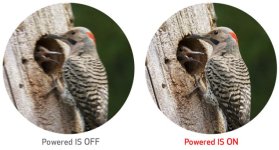The difference between a normal 8x binocular and a 12x IS binocular like the Canon 12x36 IS III binocular is huge. Even when you compare a traditional 8x binocular to an 8x IS the binocular the IS binocular will resolve almost 40 % more detail and when you move up in magnification from an 8x to 12x the difference in resolution and the detail you can see is multiplied. It is a fact that handheld a $500 Canon 8x20 IS will kill a $3000 Swarovski NL 8x42 in resolving detail. The Canon 12x36 IS III is almost like having a portable spotting scope compared to a regular binocular. The IS binoculars are especially good when you are trying to spot something moving at a great distance, like a a raptor or aircraft.I have my doubts about that statement. If you couldn't even spot them with an 8x you almost certainly can't ID them with 12x, IS or no IS. The difference between 8x and 12x is not big enough. Unless you ID them just by flight pattern. But even with IS you will not see much details when they are really that far away that you cannot see them AT ALL in an 8x bino.
Just testing this as there are a lot of birds in the sky currently here and the ones that are that far away that I can barely see them with an 8x are not really much bigger with a 12x. That wouldn't change with IS. Maybe if I get out my 18x50IS the difference in magnification would be big enough.
I like IS as much as the next guy but it really isn't the "silver bullet" that some people think it is.

Canon 10x42 IS L Tripod vs hand-held vs IS testing
That was the "probable cause", subsequent testing using the Roddier method found somewhat more error than predicted. This method uses a star test based on the fact that known defocus intra and extra focus should be exactly the same. The light is measured and Zernike polynominals are generated...
Last edited:









